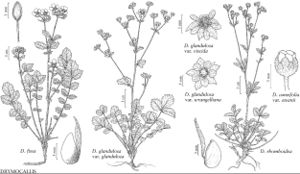Drymocallis fissa
Monogr. N. Amer. Potentilleae, 197. 1898.
Caudex branches short-to-elongate. Stems tufted to loosely spaced, (1.2–) 1.5–3.5 (–4.5) dm; base (1.5–) 2–3 mm diam., ± densely septate-glandular. Leaves sparsely to moderately hairy; basal (3–) 7–19 cm, leaflet pairs (4–) 5–6 (–10; additional reduced leaflets sometimes interspersed); terminal leaflet usually broadly obovate-cuneate, sometimes elliptic, (1–) 1.5–3.5 (–5) × (1–) 1.5–3 (–3.5) cm, teeth single or double, 5–13 per side, apex rounded to obtuse; cauline 1–3, well developed, leaflet pairs 4–6 (–10). Inflorescences 5–15-flowered, leafy, congested to ± open, 1/6–1/2 of stem, narrow to wide, branch angles 15–30 (–40) °. Pedicels 1–12 mm, short-hairy, septate-glandular. Flowers opening widely; epicalyx bractlets linear-oblanceolate, 3–7 × 1–2 mm; sepals spreading, 6–10 mm, apex acute to acuminate; petals overlapping, spreading, yellow, broadly obovate, 7–11 × 5–11 mm, equal to or exceeding sepals; filaments 1.5–4.5 mm, anthers (0.7–) 1–1.4 mm; styles thickened, 1 mm. Achenes light-brown, 1 mm.
Phenology: Flowering May–Aug.
Habitat: Sagebrush slopes, open forests, stream banks, often in rocky or moderately disturbed sites
Elevation: 1600–3000 m
Distribution

Colo., S.Dak., Utah, Wyo.
Discussion
Drymocallis fissa is distinctive in its relatively numerous leaflets (often with additional smaller ones), large flowers, and large, elongate anthers. It is most abundant in the Colorado Front Range, extending into the Medicine Bow Mountains of Wyoming. Outlying populations occur at least as far north as the Bighorn Mountains of northern Wyoming and the Black Hills of South Dakota. Tentatively included here are large-anthered populations from the eastern Uintah Mountains of Utah, though these often have fewer leaflets and smaller flowers of unknown color; they may represent a unique taxon worthy of separate recognition. Possible collections of D. fissa from New Mexico, including the type of Potentilla fissa var. major Torrey & A. Gray, are of uncertain placement in that they combine features of D. arguta, D. arizonica, and D. fissa. Reports from other states, including Montana, are probably all based on misidentified specimens.
Selected References
None.
Lower Taxa
"thin" is not a number."dm" is not declared as a valid unit of measurement for this property."dm" is not declared as a valid unit of measurement for this property.
